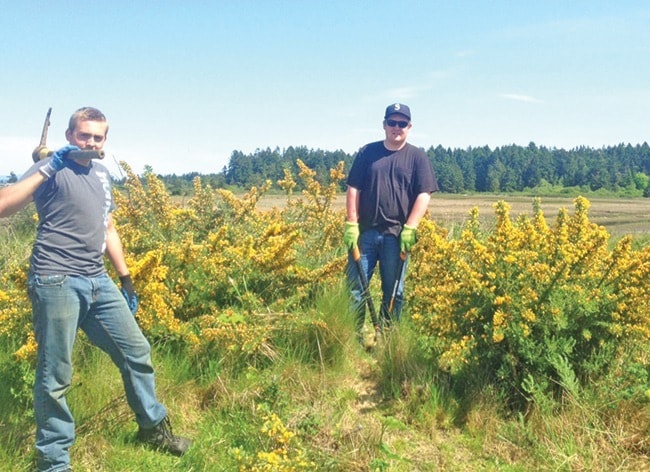A Nature Trust, HSBC Conservation Youth Crew was busy removing gorse from the Englishman River Estuary recently.
Gorse (ulex europaeus), also known as Irish hedge, looks a lot like the locally notorious Scotch broom, with little yellow flowers, but the stems are thorny and the seeds are much harder to get rid of according to experts.
"All we could do was cut it as close to the root-wad as possible and dig it out the best we could to prevent it from spreading, we'll continue to monitor and do a larger scale removal in the future. Nasty stuff!" said Steven Godfrey by e-mail of the crew's efforts in the estuary and other sites around Parksville.
While broom has started receiving attention as an invasive species in Parksville Qualicum Beach, unlike broom, gorse can't just be cut in bloom, and is an increasing problem.
"Being a science student, the opportunity to do fieldwork throughout the summer was the most intriguing aspect of this position," said Trevor Smith, a member crew from Nanaimo.
The Nature Trust hires crews each summer to tackle conservation activities and learn employable skills including first aid, bear awareness and safe power tools use.
"I learned about the role that conservation areas play in the protection of wildlife," said Andrew Harper, another crew member from Nanaimo said in a news release.
"In an urbanized region, these designated wildlife areas act as an oasis for wildlife, making the management of these areas extremely important."
"I learned how essential land conservation is to maintaining native species in B.C." Harper said.
"In the Somenos Marsh Restoration Area (near Duncan), invasive plants such as reed canary and yellow flag iris are dominating the land and damaging the chances of native plants such as tall woolly-heads' (psilocarphus elatior) survival. Restoring the natural ecosystem has exponentially increased the number of tall woolly-heads plants."
"The most enjoyable project was at the Tofino Mudflats Wildlife Management Area where we used paddle boards to survey the eel grass at sun rise," he said.
The crews do physical labour and attend workshops with specialists in things like bird counts and forest and wetland ecology.
This year youth crews are operating across the Island and much of the province, thanks to the sponsorship from HSBC for the ninth year.
The Nature Trust helps protect the natural diversity of plants and animals through the acquisition and management of critical habitats, with more than 70,000 hectares (173,000 acres) across B.C.
For more on broom and gorse visit www.broombusters.org under the "About Broom" tab. For more on the nature trust visit www.naturetrust.bc.ca.
